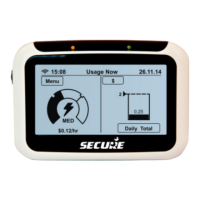3 About Pipit 500
Pipit 500 is intended for use inside the consumer’s home. It operates primarily on mains power via a DC adapter
and typically consumes less than 0.6 watt. The touch-screen display shows power usage and electricity
consumption in near real-time. When operating on battery power the display will automatically turn off after
approximately 90 seconds.
3.1 LCD user interface
The touch-sensitive LCD screen is the user interface that displays energy usage information from the Smart
Meter and allows users to configure visual and audible alerts for energy usage and message notification. The
icons, buttons and information on the touch-screen will change depending on the operation being performed.
The screen is a 3.4” monochrome display with backlight that illuminates when the unit is powered up. The
backlight can be configured to turn off after one minute if there is no user interaction.
3.2 Information on the LCD
Pipit displays net energy consumption or generation (kWh), near real-time net power consumption or generation
(kW), energy cost per hour ($/hr) and carbon emissions (CO
2
kg/hr). In addition, it indicates Pipit’s network
connection status and low-battery charge condition when operated on battery power.
Pipit can store historical data on net energy consumption and generation, cost and CO
2
emissions, enabling
consumers to compare their consumption for current and previous day, week, month and year.
Note: Refer Section 6 ‘Getting started’ for more details.
3.3 LEDs
Pipit has two LEDs on its top edge. The tri-colour electricity LED on the left-hand side indicates the net power
being consumed; the colour of the LED changes to red, amber or green depending upon the consumption level.
The colour of the LED indicates power levels as follows:
● Green for Economy (ECO) when the instantaneous power usage level is low
● Amber for Medium (MED) when the instantaneous power usage level is moderate
● Red for High (HI) when the instantaneous power usage level is high
Message notification LED

